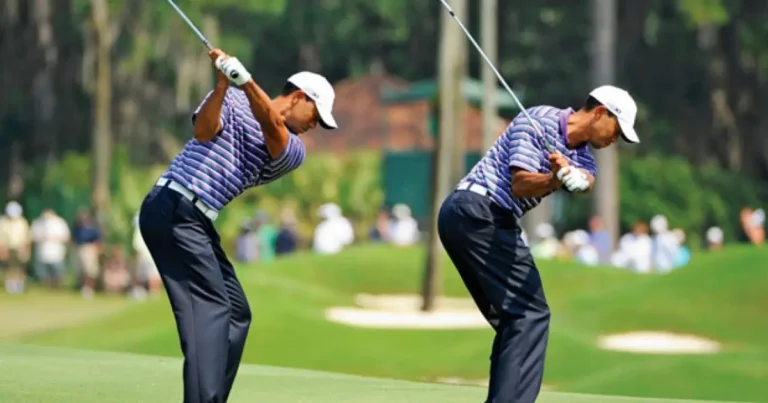Pitching vs. Chipping Approaches in the Short Game
Pitching and chipping are critical close-range shot types that require unique setups and mechanics. Both produce lofted trajectories that land softly, but they serve different purposes. Recognizing the differences between pitching and chipping and knowing when to use either around greens is required for mastering gap yardage skills.
Golf Pitching Strategy
Pitching strokes cover 20-50 yards from targets and fly higher with a moderate release. Stopping spin is produced by a sharply descending clubhead presentation at impact on these controlled shots. Pitches rise then descend as the clubface closes. Elite precision is achieved by relaxed acceleration into firm wrist hinges.
Because of poor mechanics and improper loft, inexperienced pitchers pitch inconsistently. Swings that are steep and tense add too much spin, sacrificing direction. Pitching correctly entails shallowing the club’s approach and using enough loft to carry the ball precisely.
Matching optimal angles, centeredness, and arm-speed improves feel for Yardages that necessitate longer runouts.
Shallowing necessitates specific setup elements that promote sweeping contacts. Widen the base, move forward, open the clubface, and hinge the wrists to create space for a smooth release.
Simplify the process by visualizing brushing turf and gently compressing a ball back into the air. Smooth tempo develops natural distance control with a variety of lofted clubs.
Golf Chipping Definition
On punchier lines, chipping motions keep trajectories lower, clearing close trouble cleanly. These basic strikes use clubs with less loft to bump balls onto greens without backspin. Shots must be grounded with minimal lower body movement and quiet upper body action.
Chips rely on non-dominant forearms to support the steel shaft during impact, preventing hand and wrist breakdown. To avoid opening too soon, simply putt the handle end first, releasing the toe last.
Allowing the hozzle to pass directly over the ball prevents the blade from rotating and de-lofting.
Because wider arcs instinctively steepen, limiting swing width controls ascension. Find chipping success by using quiet feet and compact swinging motions. Resist exaggerated posture changes by keeping your chest and chin still. In chipping scenarios requiring precision, prioritize compactness and level repeatability over power.
Finding Proper Pitching Situations
Pitching opportunities are determined by assessing lies, trouble hazards, and green conditions. Unobstructed yardages of less than 50 yards are ideal for flighted run ups. Additionally, pitches that emerge from tangled lies or abrupt bunker lips necessitate lofted bookmarks shine.
Plush turf and soft greens welcome medium release pitches that bump and hold predictably. Top-spun strokes bounce erratically on hard or downslope surfaces, favoring lower bump options.
However, slope and wind direction play a significant role in determining whether enough air is available to hold firm or fall off hills smoothly.
Crossing over sharp bunkers or short water hazards demonstrates safe, accurate pitch placement. Limiting rollout and chasing on reachable par 5s creates opportunities for smart eagle shots. Pitch and runs can also effectively attack tucked-away hole locations. Profit by understanding sustained carry distance control.
Choosing the Best Chipping Conditions
Chipping is the quickest way to get onto putting surfaces from tight lies or clean footholds. Unobstructed uphill chips provide the necessary momentum to climb slopes smoothly. Furthermore, shorter grass fringes provide better odds of determining precise carry distance.
Chip shots roll true once they hit the green thanks to fast pure surfaces and downgrain trajectories. Poana grasses in certain climates consistently respond to bump and run effects with less guesswork. Bermuda and Ryegrass surfaces frequently reveal subtle slopes and textures that make putting difficult at times.
Chipping additional challenges obscured trouble or forced carries safely approaching greens. Exploding through sand and landing softly is especially important on plugged bunker sides. Uneven lies in longer grass make putting difficult, requiring an advanced chipping technique. When deciding between chip and pitch, consider shot requirements, abilities, and priority outcomes.
Pitching Setup and Motion Fundamentals
Flushed pitches begin with a spacious posture, rhythm, and the ability to approach shallowly. Increase stance width by expanding potential coil while emphasizing flex at address. Targeted vision maintains athletic spine angle while clearing lower half turn space.
As athletic motion initiates the takeaway outside hands path, featherweight grip pressure naturally secures the club. As centered rotation unwinds behind you, favor the slant shaft plane by tracing a gradual arc. Patient tempo trains sequencing while minimizing lag for maximum whip.
Forward weight propels a clearing and brushing movement that descends just millimeters into the turf. Light crisp contact sounds with ingrain transitioning weight fully left, compressing through impact. Followthrough envelops the core naturally, guiding lofted shots to apex conversions down the target line. Embed emotions while repeating with calibration dedication.
Chipping Setup and Motion Fundamentals
Chipping consistency is maintained through subtle setup and minimally dynamic swings. Stance establishes a consistent rhythm, so anchor midfoot while avoiding excessive heel or toe rocking. To reduce swaying behind strokes, play the ball off the front foot.
Grip end relaxed pressurelessly in fingers, naturally supporting steel down forearms. Narrowing the stance into the ball trains compact motion, reducing wasted effort. Use fundamental putting grip techniques to eliminate excess hand action.
Simplify and target the entire process. Chip strokes keep the spine in a neutral position, identify intermediate checkpoints, and strike firmly through modest backswings. Contact is made solely as the shaft predictably hinges into the front wrist, extending the face to launch.
As the clubhead brushes cleanly then exits acutely left of target, low point control limits divots. Ingrain passive rhythm, repeating motions as little as possible to imprint technique.
Conclusion
To master the short game, you must first recognize effective chipping and pitching opportunities. Learn signature shot shapes, impact sequences, and signature setups. Control the trajectory, spin rates, and release points based on the distances required and the surface elements available. Matching intent and execution develops go-to skills that result in lower scores over time.







